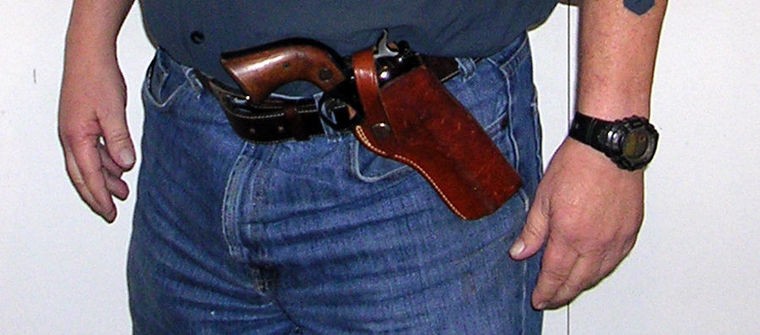Cross draw carry isn’t new. Cowboys of the 1800s and early 1900s often carried cross draw so their revolvers wouldn’t get in the way of the work they performed on the ranch.
Today, cross draw carry is usually where the handgun is worn in front of the non-dominate hip at waist level, with the muzzle pointing toward the outside of the body and the grip facing toward the dominate hand.
An exception to the above is the shoulder carry variation, where the handgun hangs in a holster under the non-dominate arm, with the butt of the handgun facing forward.
The draw is performed by the dominate hand crossing the torso, grasping the handgun, bringing the handgun back across the torso and pointing it at the target.
The advantages of cross draw carry are easy access to the handgun while seated, such as while driving long distances as truckers and body guards often do, or for anyone else that sits at a desk. It’s also good for wheelchair-bound folks.
Cross draw carry is also an option for a second or backup gun. Some police units are required to carry two handguns and cross draw is one choice, in addition to the FBI carry on the dominant side, where the primary pistol is usually carried.
I also like to carry a large-caliber single-action revolver in cross draw when I am hunting, so it won’t continually scrape against my rifle, which I often have slung over the shoulder of my dominate side.
There are also orthopedic or medical reasons one might choose to carry in cross draw. Some injuries to the strong side hip area can make it agonizing to wear a firearm there, but the weight can be born on the opposite hip.
Some people find it easier to learn cross draw with their dominate hand than learning conventional hip draw with their “weak” hand.
Certain shoulder injuries, particularly those involving the rotator cuff, can limit the ability of the patient to draw from a strong side hip position, but do not impede access to a holstered firearm in cross draw position. Some people with bad backs or hip conditions require weight to be removed from the pelvic area where possible. After some abdominal or hip surgeries, doctors recommend the patient not even wear a belt during the recovery period.
Another advantage of cross draw carry is that one can easily appear to be just folding the arms where the handgun can be accessed if they feel threatened, but don’t feel justified in displaying the firearm yet. The shooter can even draw the weapon and keep it hidden under a jacket to speed the draw if the threat level increases to where a reasonable fear of great bodily injury or death is perceived.
But there are disadvantages of cross draw carry. For one, it is easier to disarm somebody who is carrying cross draw with the grip of the handgun facing forward. It also requires a longer and slower draw stroke to reach across the torso to access the handgun.
The muzzle of the handgun covers a wide arch from the non-dominate side of the shooter until it is brought to index the target during cross draw, unless one is properly trained in keeping the handgun low (without shooting oneself in the foot) and pushing it straight out to index the target.
When worn in cross draw carry, a handgun is difficult to conceal with the exception of the shoulder holster version. When worn in a shoulder holster, the pistol is either worn with the muzzle pointing straight down, possibly indexing the shooters non-dominate leg at times, or pointed straight back and down a little at whatever is behind the shooter.
The handgun is not difficult to conceal under a sweater or jacket, but the shooter must be very careful to have any safeties engaged. I don’t think the public would be comfortable if they knew the individual just ahead of them was wearing a pistol that was pointed straight behind. I certainly wouldn’t.
Cross draw is not allowed in some combat shooting sports, a number of shooting academies, police academies and police departments. The reason is that when standing facing the target at the range, the cross draw can swing the muzzle of the loaded handgun across the shooter on the holster side and perhaps even the range safety officer behind the firing line. Being prohibited in so many venues makes it hard for one to practice and become proficient in the cross draw technique.
If you choose cross draw carry, make sure that it is the best option for your circumstances and find a good instructor and place where you can became proficient at the technique.
Smokey Merkley was raised in Idaho and has been hunting since he was 10 years old. He was a member of the faculty of Texas A&M University for 25 years. There he taught orienteering, marksmanship, self-defense, fencing, scuba diving and boxing. He was among the first DPS-certified Texas Concealed Handgun Instructors. He can be contacted at mokeydo41245@hotmail.com.



